
| Version | Summary | Created by | Modification | Content Size | Created at | Operation |
|---|---|---|---|---|---|---|
| 1 | Assel Zhaksylyk | -- | 3318 | 2023-04-28 09:48:25 | | | |
| 2 | Lindsay Dong | -14 word(s) | 3304 | 2023-05-03 03:26:43 | | | | |
| 3 | Lindsay Dong | Meta information modification | 3304 | 2023-05-05 11:22:03 | | |
Video Upload Options
Active Front-End (AFE) rectifiers have regained momentum as the demand for highpower Electric Vehicle (EV) charging infrastructure increases exponentially. AFE rectifiers have high efficiency and reliability, and they minimize the disturbances that could be generated due to the operation of the EV charging systems by reducing harmonic distortion and operating close to the Unity Power Factor (UPF).
1. Introduction
Electric Vehicle (EV) chargers can be classified into three levels based on their power rating, as shown in Table 1. Moreover, they are also categorized as on-board and off-board based on their location. On-board chargers have the convenience of being fairly independent of the charging infrastructure and having the freedom to charge at residential or office spaces where the user would be spending time anyway. On-board chargers can be in charger power Levels 1 or 2 because they have space and weight constraints, so their power rating is limited by the power density of the converter. These chargers cannot deliver the same speed of charging as higher power off-board chargers.
| EVC Level | Voltage Level (US/EU) | Grid Supply | Location | Power | Charging Time |
|---|---|---|---|---|---|
| Level 1 | 120/230 VAC | 1-phase | On-board | <3.7 kW | 8–16 h |
| Level 2 | 240/400 VAC | 1- or 3-phase | On- or Off-board | 3.7–22 kW | 2–6 h |
| Level 3 | 208–600 VDC | 3-phase | Off-board | 22–350 kW | 10–30 min |
| Ultra-fast charger | >800 VDC | 3-phase | Off-board | >400 kW | 5–15 min |
2. Comparison of Active Front-End (AFE) Topologies
The unidirectional rectifiers only support drawing power from the grid to charge the EV battery. Examples of unidirectional rectifiers include simple diode bridge rectifiers, Vienna rectifiers, Swiss rectifiers, and other well-established topologies. The bidirectional rectifiers can feed power from the vehicle back to the grid when necessary. The V2G operation has been proven beneficial in lower-power chargers, while its use in high-power chargers is relatively new. Level 3 bidirectional AFE rectifiers with V2G capabilities are used in DC fast charging stations with renewable energy sources and energy storage systems to offset the effect of the fast chargers on the grid and to provide additional grid services [5][6]. Within bidirectional rectifiers, there are two types: boost-type and buck-type. The boost-type rectifiers have higher DC link voltage compared to the AC side voltage, while it is the opposite for the buck-type. The higher DC link voltage means less current for the same power level, which can be beneficial, especially for high-power systems.
-
Three-phase boost-type rectifier topology suitable for Level 3 DC fast charging or ultra-fast charging;
-
Injects minimal THD to the grid;
-
Bidirectionality is advantageous since it enables a V2G operation;
-
Smaller number of components is advantageous for system reliability and cost.
2.1. Three-Phase Passive Rectifier



-
Three-phase two-level six-switch boost-type rectifier;
-
Three-phase three-level neutral point clamped converter;
-
Three-phase three-level T-type converter.
2.2. Three-Phase Two-Level Six-Switch Boost-Type Rectifier
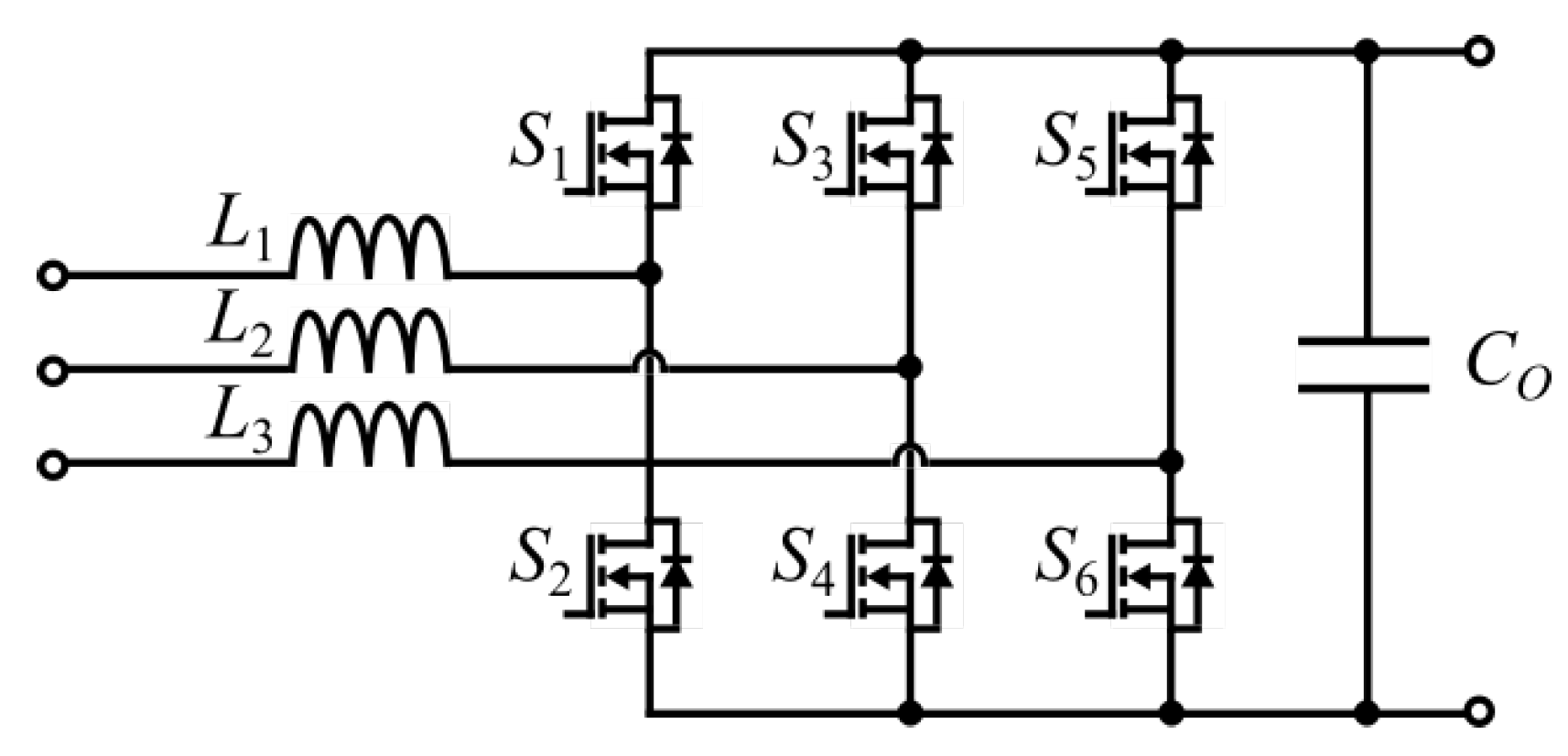
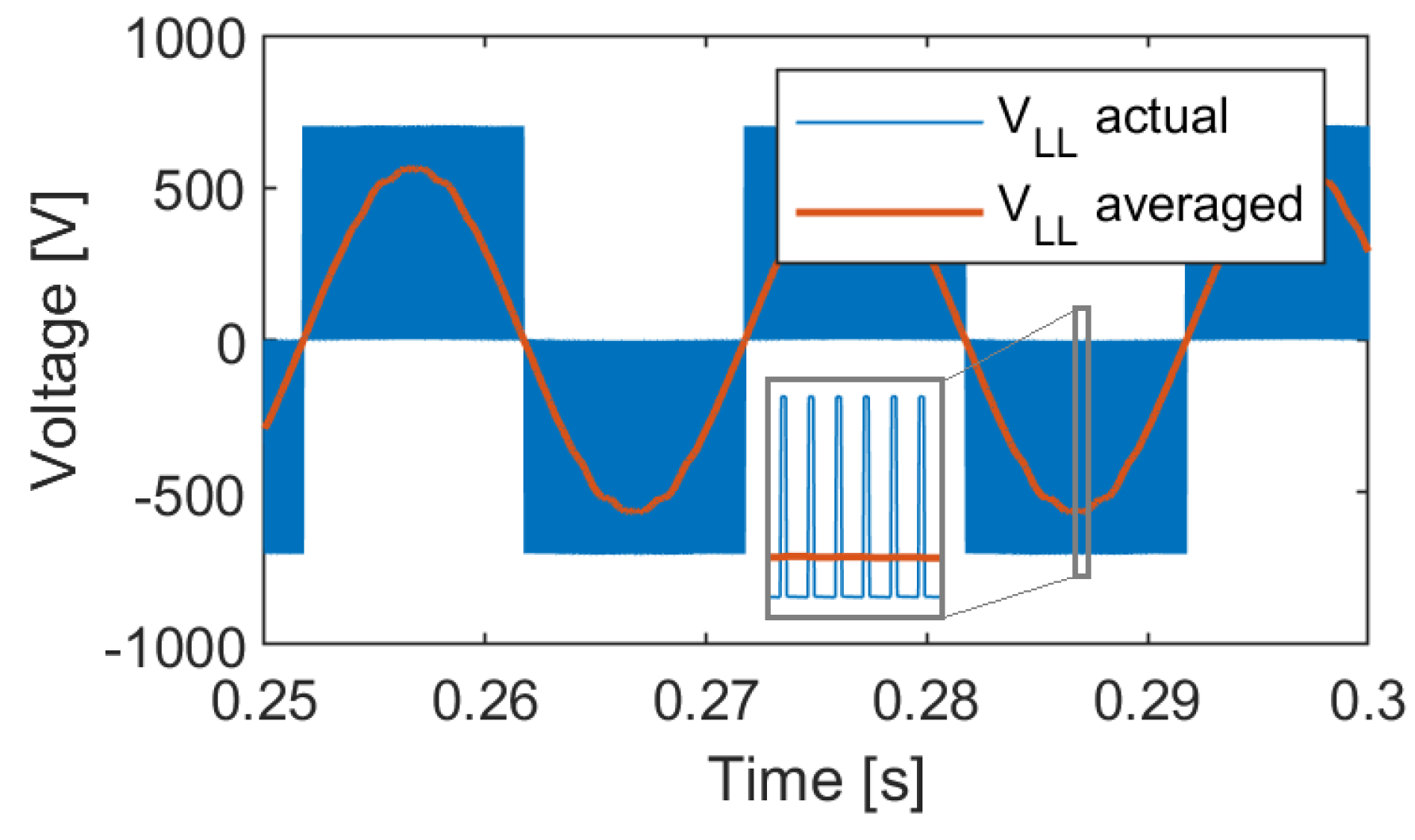
2.3. Three-Phase Three-Level Neutral Point Clamped Converter
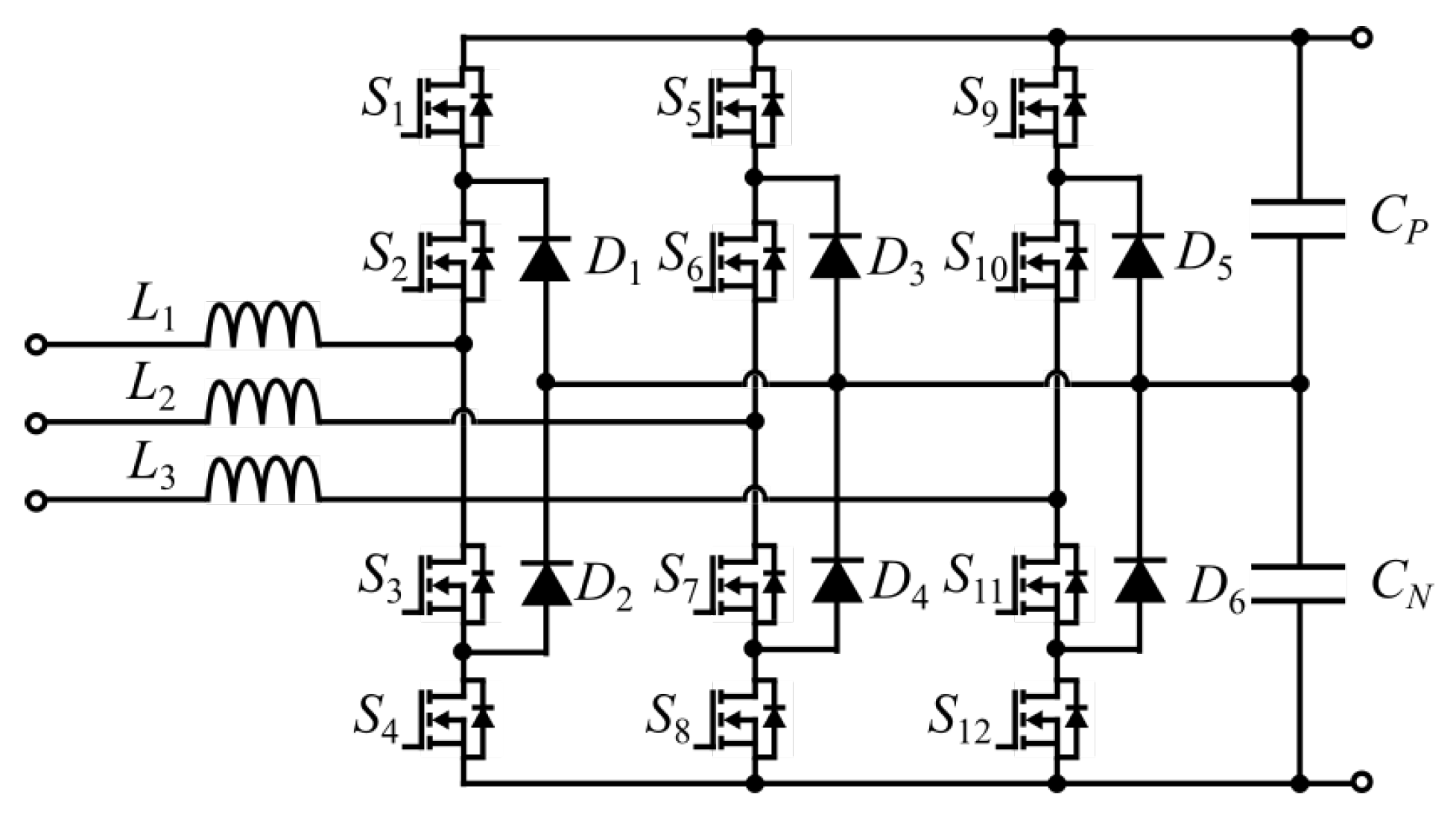
2.4. Three-Phase Three-Level T-Type Converter
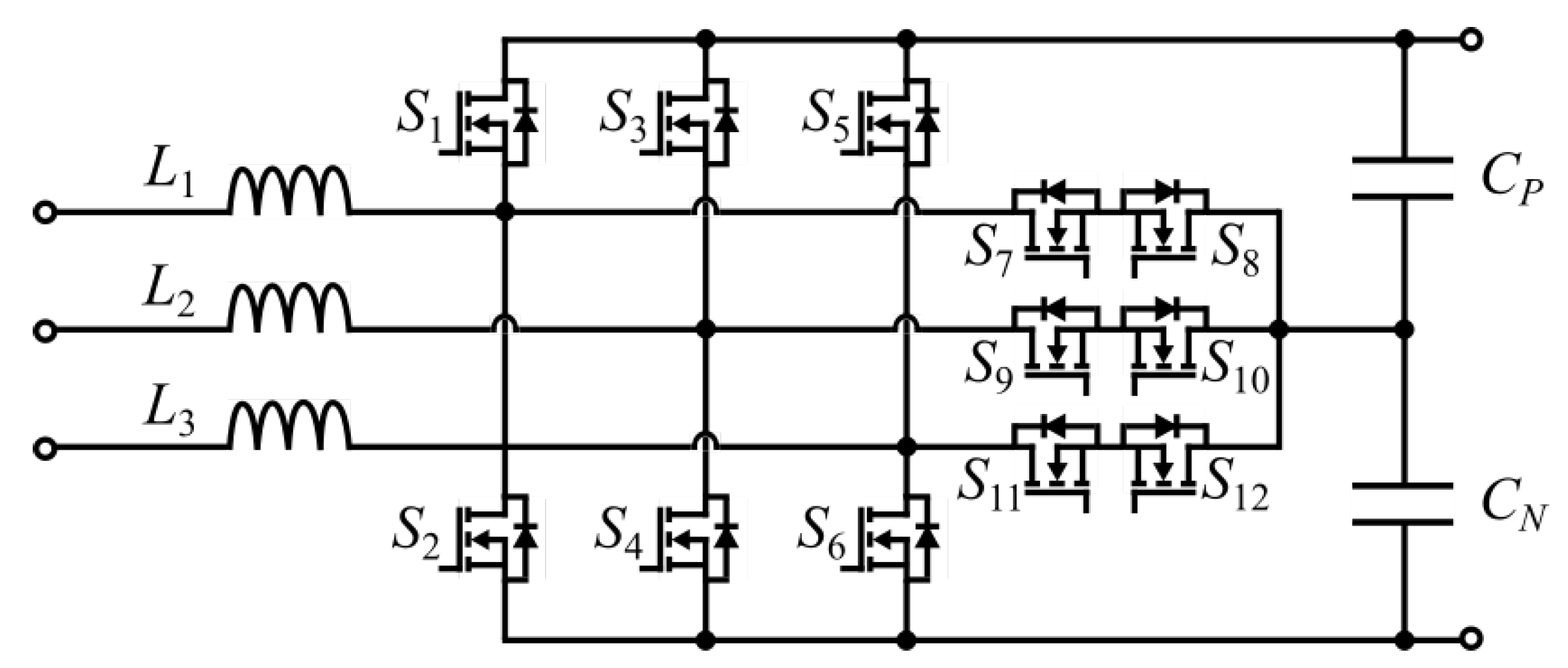
2.5. Comparison of Rectifier Topologies
| Passive Rectifier | Six-Switch Rectifier | NPC Rectifier | T-Type Rectifier | |
|---|---|---|---|---|
| Bidirectional | No | Yes | Yes | Yes |
| Output DC voltage | 505.5 V | 700 V | 700 V | 700 V |
| Output DC current | 59.3 A | 42.8 A | 42.8 A | 42.8 A |
| Efficiency | 91% | 98.5% | 98.2% | 98.95% |
| Grid current THD | 30.9% | 5% | 5% | 5% |
| Power Factor | 0.87 | 0.997 | 0.997 | 0.997 |
| Number of active switches | 0 | 6 | 12 | 12 |
| Number of passive switches | 6 | 0 | 6 | 0 |
| Switch blocking voltage stress | VDC��� | VDC��� | 0.5 VDC��� | VDC��� (6), 0.5 VDC��� (6) |
| DC link capacitance for 1% VDC��� ripple | 3000 μF | 87 μF | 2 × 350 μF | 2 × 350 μF |
| DC link capacitor voltage rating | VDC��� | VDC��� | 0.5 VDC��� | 0.5 VDC��� |
| AC side inductance for 5% THD | 0.96 mH | 0.44 mH | 0.238 mH | 0.238 mH |
| Cost | Low | Average | High | High |
| Reliability | High | Higher stress on individual components, Lower component count | Lower stress on individual components, higher component count | Lower stress on individual components, higher component count |
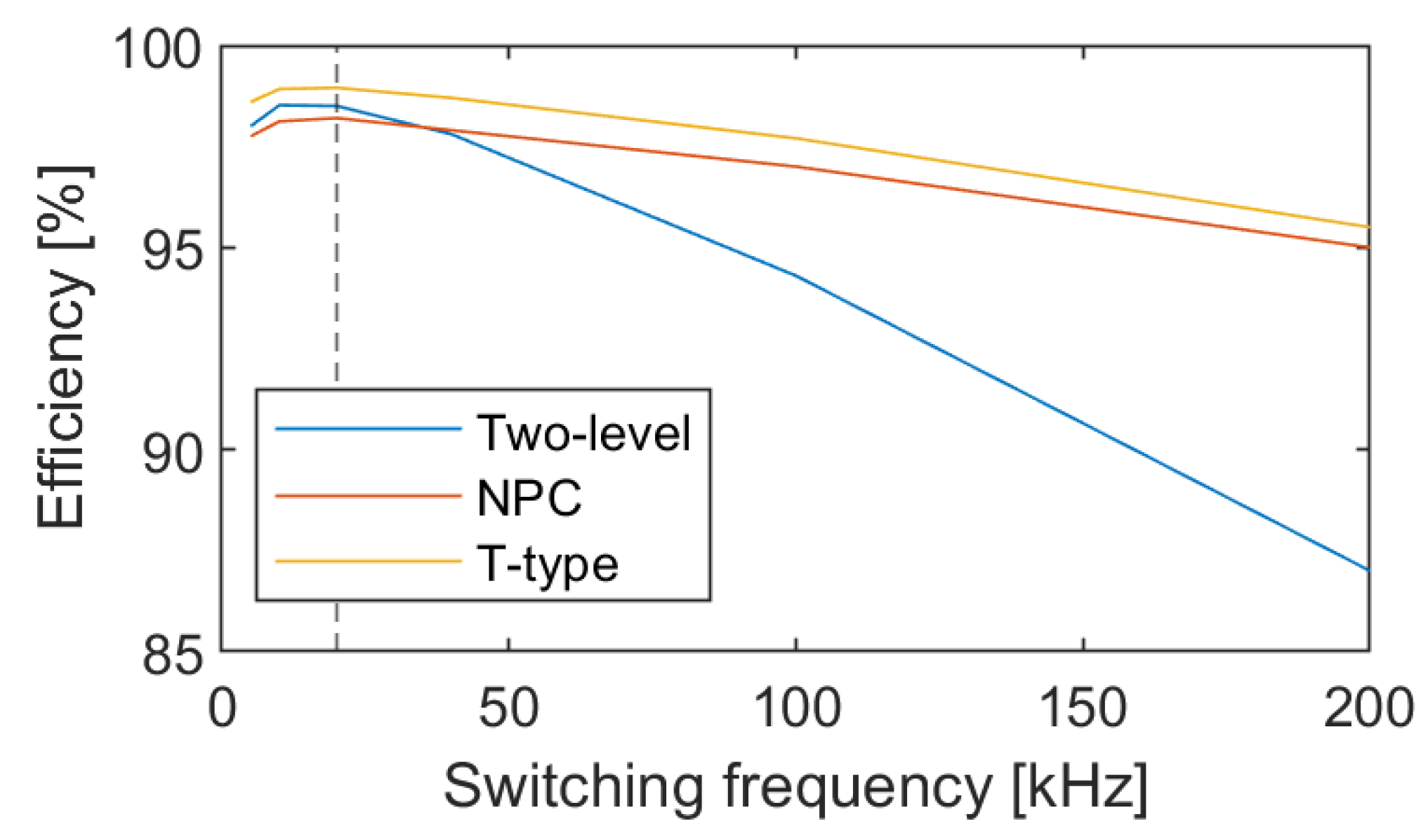
3. Components of AFE Rectifiers
3.1. Power Semiconductor Selection
3.2. DC Link Capacitor Selection
3.3. Grid Side Filters Selection
4. Control of a Single AFE
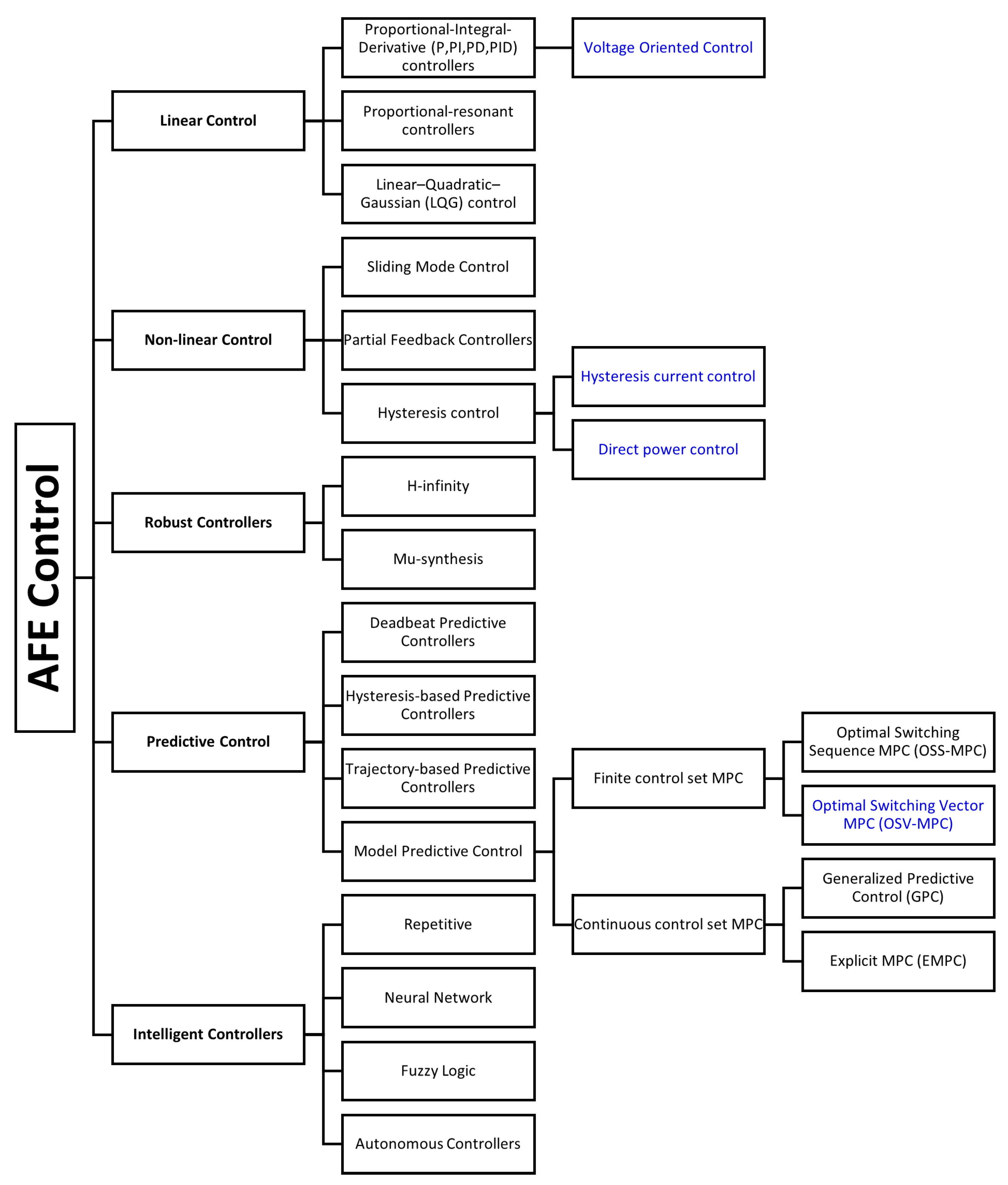
-
Voltage Oriented Control (VOC) is a type of Linear Control with PI controllers.
-
Direct Power Control (DPC) is classified under Non-linear Hysteresis Control since active and reactive power is controlled using a hysteresis controller with a lookup table.
-
Optimal switching vector Model Predictive Control (MPC) is classified under Predictive Control.
-
Hysteresis Current Control (HCC) is a type of Non-linear Hysteresis Control applied directly to phase currents.
5. Modular AFE

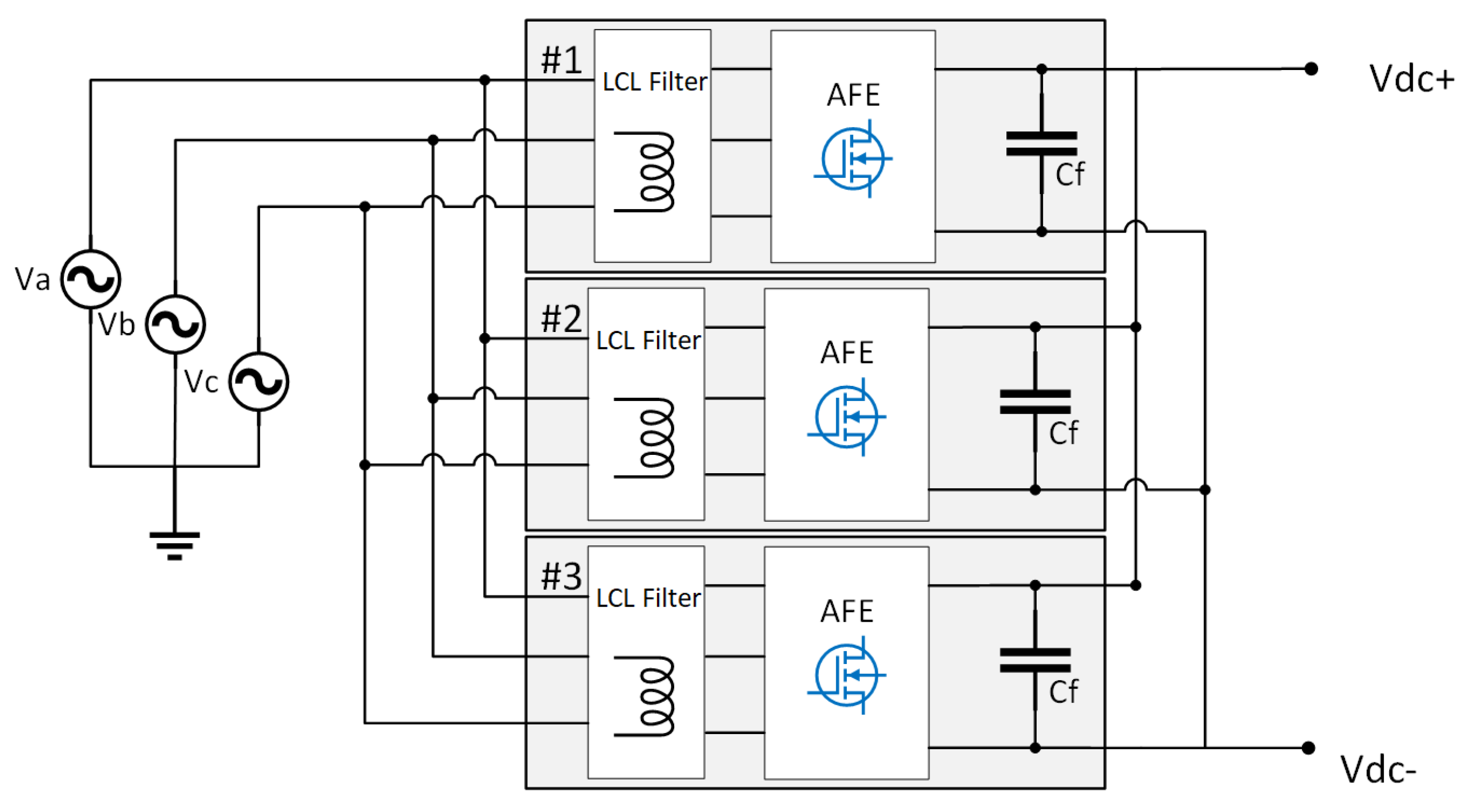

6. Cooling System
References
- Yilmaz, M.; Krein, P.T. Review of Battery Charger Topologies, Charging Power Levels, and Infrastructure for Plug-In Electric and Hybrid Vehicles. IEEE Trans. Power Electron. 2013, 28, 2151–2169.
- Zamani, M.; Nagrial, M.; Rizk, J.; Hellany, A. Electric Vehicles Charging: Review of Current Status. In Proceedings of the 2018 Australasian Universities Power Engineering Conference (AUPEC), IEEE, Auckland, New Zealand, 27–30 November 2018; pp. 1–5.
- Jaman, S.; Chakraborty, S.; Tran, D.D.; Geury, T.; El Baghdadi, M.; Hegazy, O. Review on Integrated On-Board Charger-Traction Systems: V2G Topologies, Control Approaches, Standards and Power Density State-of-the-Art for Electric Vehicle. Energies 2022, 15, 5376.
- Rasool, H.; Verbrugge, B.; Zhaksylyk, A.; Tran, T.M.; Baghdadi, M.E.; Geury, T.; Hegazy, O. Design Optimization and Electro-Thermal Modeling of an Off-Board Charging System for Electric Bus Applications. IEEE Access 2021, 9, 84501–84519.
- Zabetian-Hosseini, A.; Joos, G.; Boulet, B. Distributed Control Design for V2G in DC Fast Charging Stations. In Proceedings of the 2021 IEEE Energy Conversion Congress and Exposition (ECCE), IEEE, Vancouver, BC, Canada, 10–14 October 2021; pp. 655–661.
- Chandler, S.; Gartner, J.; Jones, D. Integrating Electric Vehicles with Energy Storage and Grids: New Technology and Specific Capabilities Spur Numerous Applications. IEEE Electrif. Mag. 2018, 6, 38–43.
- Krasselt, P.; Boßle, J.; Suriyah, M.; Leibfried, T. DC-Electric Vehicle Supply Equipment Operation Strategies for Enhanced Utility Grid Voltage Stability. World Electr. Veh. J. 2015, 7, 530–539.
- Kolar, J.W.; Friedli, T. The Essence of Three-Phase PFC Rectifier Systems—Part I. IEEE Trans. Power Electron. 2013, 28, 176–198.
- Friedli, T.; Hartmann, M.; Kolar, J.W. The Essence of Three-Phase PFC Rectifier Systems—Part II. IEEE Trans. Power Electron. 2014, 29, 543–560.
- Halbig, J. 15 kW Bidirectional Vienna PFC. In Proceedings of the APEC2020, New Orleans, LA, USA, 15–19 March 2020.
- Schweizer, M.; Kolar, J.W. Design and Implementation of a Highly Efficient Three-Level T-Type Converter for Low-Voltage Applications. IEEE Trans. Power Electron. 2013, 28, 899–907.
- Su, G.J. Comparison of Si, SiC, and GaN based Isolation Converters for Onboard Charger Applications. In Proceedings of the 2018 IEEE Energy Conversion Congress and Exposition (ECCE), IEEE, Portland, OR, USA, 23–27 September 2018; pp. 1233–1239.
- Gu, X.; Shui, Q.; Myles, C.; Gundersen, M. Comparison of Si, GaAs, SiC and GaN FET-type switches for pulsed power applications. In Proceedings of the Digest of Technical Papers, PPC-2003, 14th IEEE International Pulsed Power Conference (IEEE Cat. No.03CH37472), IEEE, Dallas, TX, USA, 15–18 June 2003; pp. 362–365.
- Liu, G.; Bai, K.H.; McAmmond, M.; Brown, A.; Johnson, P.M.; Taylor, A.; Lu, J. Comparison of SiC MOSFETs and GaN HEMTs based high-efficiency high-power-density 7.2 kWEV battery chargers. In Proceedings of the 2017 IEEE 5th Workshop on Wide Bandgap Power Devices and Applications (WiPDA), IEEE, Albuquerque, NM, USA, 30 October–1 November 2017; pp. 391–397.
- Abramushkina, E.; Zhaksylyk, A.; Geury, T.; El Baghdadi, M.; Hegazy, O. A Thorough Review of Cooling Concepts and Thermal Management Techniques for Automotive WBG Inverters: Topology, Technology and Integration Level. Energies 2021, 14, 4981.
- Zhang, D.; Guacci, M.; Haider, M.; Bortis, D.; Kolar, J.W.; Everts, J. Three-Phase Bidirectional Buck-Boost Current DC-Link EV Battery Charger Featuring a Wide Output Voltage Range of 200 to 1000 V. In Proceedings of the 2020 IEEE Energy Conversion Congress and Exposition (ECCE), IEEE, Detroit, MI, USA, 11–15 October 2020; pp. 4555–4562.
- Liu, Z.; Li, B.; Lee, F.C.; Li, Q. High-Efficiency High-Density Critical Mode Rectifier/Inverter for WBG-Device-Based On-Board Charger. IEEE Trans. Ind. Electron. 2017, 64, 9114–9123.
- Wang, H.; Blaabjerg, F. Reliability of Capacitors for DC-Link Applications in Power Electronic Converters—An Overview. IEEE Trans. Ind. Appl. 2014, 50, 3569–3578.
- Das, J. Harmonic Distortion Limits According to Standards. In Power System Harmonics and Passive Filter Designs; John Wiley & Sons, Inc: Hoboken, NJ, USA, 2015; pp. 427–451.
- Yagnik, U.P.; Solanki, M.D. Comparison of L, LC & LCL filter for grid connected converter. In Proceedings of the 2017 International Conference on Trends in Electronics and Informatics (ICEI), IEEE, Tirunelveli, India, 11–12 May 2017; pp. 455–458.
- Qian, H.; Xu, J.; Hu, Y.; Xie, S. Design and Comparison of High-Order Output Filters for Grid-Connected Converters with Low Switching Frequency. In Proceedings of the 2021 IEEE 16th Conference on Industrial Electronics and Applications (ICIEA), IEEE, Chengdu, China, 1–4 August 2021; pp. 894–899.
- Safayatullah, M.; Elrais, M.T.; Ghosh, S.; Rezaii, R.; Batarseh, I. A Comprehensive Review of Power Converter Topologies and Control Methods for Electric Vehicle Fast Charging Applications. IEEE Access 2022, 10, 40753–40793.
- Athari, H.; Niroomand, M.; Ataei, M. Review and Classification of Control Systems in Grid-tied Inverters. Renew. Sustain. Energy Rev. 2017, 72, 1167–1176.
- Kazmierkowski, M.; Malesani, L. Current control techniques for three-phase voltage-source PWM converters: A survey. IEEE Trans. Ind. Electron. 1998, 45, 691–703.
- Gray, M.; Gao, Z.; Button, R. Distributed, Master-less Control of Modular DC-DC Converters. In Proceedings of the 2nd International Energy Conversion Engineering Conference, Rhodes, Greece, 16–19 August 2004; American Institute of Aeronautics and Astronautics: Reston, VA, USA, 2004.
- Zhaksylyk, A.; Rasool, H.; Geury, T.; El Baghdadi, M.; Hegazy, O. Masterless Control of Parallel Modular Active front-end (AFE) Systems for Vehicles and Stationary Applications. In Proceedings of the 2020 Fifteenth International Conference on Ecological Vehicles and Renewable Energies (EVER), IEEE, Monte-Carlo, Monaco, 10–12 September 2020.
- Salgado-Herrera, N.; Anaya-Lara, O.; Campos-Gaona, D.; Medina-Rios, A.; Tapia-Sanchez, R.; Rodriguez-Rodriguez, J. Active Front-End converter applied for the THD reduction in power systems. In Proceedings of the 2018 IEEE Power & Energy Society General Meeting (PESGM), IEEE, Portland, OR, USA, 5–10 August 2018.
- Zhaksylyk, A.; Hasan, M.M.; Chakraborty, S.; Geury, T.; Hegazy, O. Effects of modularity on the performance and reliability of SiC MOSFET-based active front-end rectifiers in EV charging application. In Proceedings of the IECON 2022—48th Annual Conference of the IEEE Industrial Electronics Society, IEEE, Brussels, Belgium, 17–20 October 2022; pp. 1–7.
- Xing, K.; Lee, F.; Borojevic, D.; Ye, Z.; Mazumder, S. Interleaved PWM with discontinuous space-vector modulation. IEEE Trans. Power Electron. 1999, 14.
- Lyu, J.; Zhang, J.; Cai, X.; Wang, H.; Dai, J. Circulating current control strategy for parallel full-scale wind power converters. IET Power Electron. 2016, 9, 639–647.
- Wang, J.; Hu, F.; Jiang, W.; Wang, W.; Gao, Y. Investigation of Zero Sequence Circulating Current Suppression for Parallel Three-Phase Grid-Connected Converters Without Communication. IEEE Trans. Ind. Electron. 2018, 65, 7620–7629.
- Zeng, Z.; Zhang, X.; Blaabjerg, F.; Chen, H.; Sun, T. Stepwise Design Methodology and Heterogeneous Integration Routine of Air-Cooled SiC Inverter for Electric Vehicle. IEEE Trans. Power Electron. 2020, 35, 3973–3988.
- Bolte, S.; Henkenius, C.; Bocker, J.; Zibart, A.; Kenig, E.; Figge, H. Water-cooled on-board charger with optimized cooling channel. In Proceedings of the 2017 19th European Conference on Power Electronics and Applications (EPE’17 ECCE Europe), IEEE, Warsaw, Poland, 11–14 September 2017; pp. P.1–P.9.
- Fang, X.; Li, J.; Zhang, X.; Chen, W.; Wang, W. Study on Temperature Control Design and High Protection of Charger. In Proceedings of the 2018 10th International Conference on Intelligent Human-Machine Systems and Cybernetics (IHMSC), IEEE, Hangzhou, China, 25–26 August 2018; pp. 216–219.
- New Slim Liquid Cooled Active Front End Drive Technology Increases Power Density by 100%; Technical Report; Emotron: Helsingborg, Sweden, 2022.




